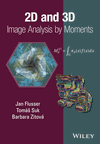Motivation
Summary
This chapter presents an overview of a key concepts discussed in the subsequent chapters of this book. The book deals systematically with moments and moment invariants of 2D and 3D images and with their use in object description, recognition, and in other applications. It introduces basic terms and concepts of object recognition such as feature spaces and related norms, equivalences, and space partitions. The book also introduces 2D moment invariants with respect to the simplest spatial transformations, translation, rotation, and scaling. It also presents the derivation of the invariants by means of three approaches, the tensor method, the expansion into spherical harmonics, and the object normalization. The book deals with moment invariants to the affine transformation of spatial coordinates. It provides four main approaches showing how to derive them in 2D, the graph method, the method of normalized moments, the transvectants, and the solution of the Cayley-Aronhold equation.



